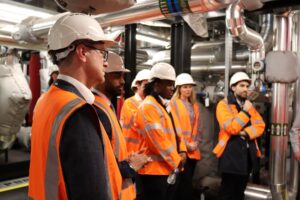Beatrice Browning, PhD researcher at the Faraday Institution writes for Air Quality News about the potential value of second-life batteries for energy storage.
The transport sector is one of the principal producers of greenhouse gas emissions in the UK. This, and the UK government’s pledge to reach net-zero CO2 emissions by 2050, has catalysed the expansion of the electric vehicle (EV) market in recent years.
Due to this increase, the number of end-of-life EV batteries are predicted to surge in the coming years.
An EV battery is generally considered to be ‘end-of-life’ when its capacity has declined to approximately 80% of its original value.
However, these spent batteries are now attracting attention from battery manufacturers and start-up companies, with their significant remaining capacity offering huge potential for use in a secondary application.
Due to the current economic and infrastructural issues faced of widespread lithium-ion battery (LiB) recycling, the second life battery (SLB) market provides a promising opportunity to deal with early generations of spent EV batteries – particularly in stationary energy storage (SES) applications.
Why do we need stationary energy storage?
SES is vital in times where electricity supply is in substantial demand.
SES can be used commercially, residentially, and industrially, in applications including charging infrastructure, off-grid energy supply, or even street lights.
SES ensures energy can be bought and stored in periods of low demand, when it is cheap, to then be used in times of high demand.
Though they are not currently using SLBs, Pivot Power, a UK-based start-up SES company, are committed to developing the world’s largest battery storage and EV charging network using stationary technology.
In 2018, Pivot Power installed of a 3.7MWh battery array at The Emirates Stadium. This array is capable of supplying electricity to power the 60,000 seater ground for a full match and placed Arsenal as a frontrunner in sustainability in sport.
On a larger scale, Pivot Power has also orchestrated the development of 2 battery storage ‘superhubs’ to be built in Oxford and Kent by 2021.
These SES hubs have not only been built to facilitate fast EV charging but also to provide the electricity capacity for EV charging on a large scale, resulting in reduced pressure on the grid.
Currently, the batteries used in these superhubs are first-life and are being supplied by the Finnish smart technology company Wärtsilä, however, it is possible that as the utilisation of spent EV batteries stationary applications grows, the supply chain for these kinds of superhub will change.
The shift towards SLBs will enable Pivot Power (and other SES providers) to provide competitive energy prices for the consumer (in 5 years’ time, projections indicated that SLBs may be up to 70% cheaper than new ones used in these SES applications!).
Issues with second-life batteries
Despite the obvious benefit of SLBs, it is crucial to note that the supply of end of life battery waste is not likely to meet the demand for stationary energy storage applications for at least a decade.
This is because capacity fade to 80% in EV batteries currently takes between 10 and 15 years (and will take even longer as battery technology advances further).
The reuse of LiBs in alternate systems is also only possible with essential rigorous and expensive testing, and the installation of sophisticated battery management systems to ensure they are safe and reliable in their new application.
The process of identifying which used batteries are suitable for a second life is known as ‘grading’.
Grading is essential for the second-life application of batteries, as the complex battery degradation mechanisms of LiBs mean that certain cells are will not be appropriate for second-life usage.
A further challenge of SLBs arises with the broad variety of EV battery pack chemistry and design between manufacturers.
By 2025, it is predicted that there will be over 200 models of EV for sale from over a dozen manufacturers, with varied battery configurations. The three predominant cellular arrangements currently seen in EVs include pouch, prismatic and cylindrical cells, all of which have an intricate design and cellular chemistries. This broad variation in pack design makes battery testing even more difficult for companies intending to repurpose these partially spent batteries.
The future of second-life batteries in stationary energy storage applications
Though there are a considerable number of issues with the use of spent EV batteries in second-life applications, there is a multitude of ways that they can be overcome.
Firstly, as legislation is being put in place for the use of LiBs in EVs, one principle focus of lawmakers is the ‘extended producer responsibility’ (EPR) of the manufacturer.
This EPR is put in place to ensure battery manufacturers to take environmental accountability for their batteries when they become waste for recycling or alternate disposal.
For the manufacturers, the issues of cellular design and testing are diminished, as they have an abundance of battery performance data to aid degradation predictions, and can design the initial batteries with the second-life application in mind.
Nissan is an example of this: they worked in conjunction with WMG, University of Warwick, to reduce the grading time of their Nissan leaf pouch cells.
The prospect of giving batteries a ‘second-life’ will also potentially enable the manufacturer to transfer their EPR onto the buyer, meaning that SLB technology is an attractive opportunity for manufacturers.
For the customer, an SES solution which provides a clean, self-regulating source of energy is extremely appealing. This, coupled with the low price of an SLB further increases the likelihood of SLB usage gaining traction.
It is also reasonable to claim that the use of spent EV batteries in SES applications will place them in a far less challenging environment than in their initial mobile one.
As these batteries have already satisfied the stringent safety assessment criteria for use in an EV, their usage in SES applications requires far less strict technical measures.
Car manufacturers including Nissan, Tesla, Audi and GM have been trialling their batteries in second-life applications, even in their own facilities. EV consumers will also benefit from the second-life application of EV batteries, as it is believed upfront EV costs will be reduced if the battery is suited for secondary battery application.
Photo Credit – Pixabay

















Leave a Reply